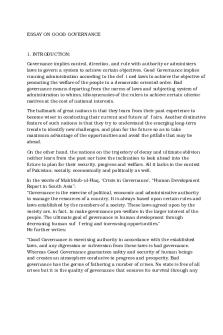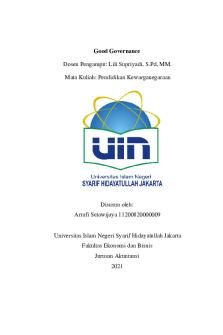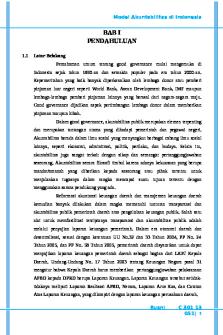Module 1 - Good Governance PDF

| Title | Module 1 - Good Governance |
|---|---|
| Author | sky Abing |
| Course | Good Governance |
| Institution | Batangas State University |
| Pages | 10 |
| File Size | 262.7 KB |
| File Type | |
| Total Downloads | 38 |
| Total Views | 493 |
Summary
1Introduction to Corporate GovernanceIntended Learning Outcome Understand the concept of governance Know the various models of corporate governance Categorize the theories affecting corporate governance developmentIntroductionThe concept of "governance" is not new. However, it...
Description
1 Introduction to Corporate Governance Intended Learning Outcome
Understand the concept of governance Know the various models of corporate governance Categorize the theories affecting corporate governance development
Introduction The concept of "governance" is not new. However, it means different things to different people, therefore we must get our focus right. The actual meaning of the concept depends on the level of governance we are talking about, the goals to be achieved and the approach being followed. The concept has been around in both political and academic discourse for a long time, referring in a generic sense to the task of running a government, or any other appropriate entity for that matter. In this regard the general definition provided by Webster's Third New International Dictionary (1986:982) is of some assistance, indicating only that governance is a synonym for government, or "the act or process of governing, specifically authoritative direction and control". This interpretation specifically focuses on the effectiveness of the executive branch of government. The working definition used by the British Council, however, emphasizes that "governance" is a broader notion than government (and for that matter also related concepts like the state, good government and regime), and goes on to state: "Governance involves interaction between the formal institutions and those in civil society. Governance refers to a process whereby elements in society wield power, authority and influence and enact policies and decisions concerning public life and social upliftment."
Figure 1. Urban Actors
"Governance", therefore, not only encompasses but transcends the collective meaning of related concepts like the state, government, regime, and good government. Many of the elements and principles underlying "good government" have become an integral part of the meaning of "governance". John Healey and Mark Robinson define "good government" as follows: "It implies a high level of organizational effectiveness in relation to policy-formulation and the policies actually pursued, especially in the conduct of economic policy and its contribution to growth, stability and popular welfare. Good government also implies accountability, transparency, participation, openness, and the rule of law. It does not necessarily presuppose a value judgement, for example, a healthy respect for civil and political liberties, although good government tends to be a prerequisite for political legitimacy". Governance can be used in several contexts such as corporate governance, international governance, national governance, and local governance. Since governance is the process of
decision making and the process by which decisions are implemented, an analysis of governance focuses on the formal and informal actors involved in decision-making and implementing the decisions made and the formal and informal structures that have been set in place to arrive at and implement the decision. Government is one of the actors in governance. Other actors involved in governance vary depending on the level of government that is under discussion. In rural areas, for example, other actors may include influential landlords, associations of peasant farmers, cooperatives, NGOs, research institutes, religious leaders, finance institutions political parties, the military etc. The situation in urban areas is much more complex. Figure 1 provides the interconnections between actors involved in urban governance. At the national level, in addition to the above actors, media, lobbyists, international donors, multi-national corporations, etc. may play a role in decision making or in influencing the decision-making process. Characteristics of Good Governance Good governance is responsive to the present and future needs of the organization, exercises prudence in policy-setting and decision-making, and that the best interests of all stakeholders are considered. The following are the eight major characteristics of good governance: 1. Rule of Law Good governance requires fair legal frameworks that are enforced by an impartial regulatory body, for the full protection of stakeholders. 2. Transparency Transparency means that information should be provided in easily understandable forms and media; that it should be freely available and directly accessible to those who will be affected by governance policies and practices, as well as the outcomes resulting therefrom; and that any decisions taken and their enforcement are in compliance with established rules and regulations. 3. Responsiveness Good governance requires that organizations and their processes are designed to serve the best interests of stakeholders within a reasonable timeframe. 4. Consensus Oriented Good governance requires consultation to understand the different interests of stakeholders to reach a broad consensus of what is in the best interest of the entire stakeholder group and how this can be achieved in a sustainable and prudent manner. 5. Equity and Inclusiveness The organization that provides the opportunity for its stakeholders to maintain, enhance, or generally improve their well-being provides the most compelling message regarding its reason for existence and value to society. 6. Effectiveness and Efficiency Good governance means that the processes implemented by the organization to produce favorable results meet the needs of its stakeholders, while making the best use of resources – human, technological, financial, natural and environmental – at its disposal. 7. Accountability Accountability is a key tenet of good governance. Who is accountable for what should be documented in policy statements? In general, an organization is accountable to
those who will be affected by its decisions or actions as well as the applicable rules of law.
8. Participation Participation by both men and women, either directly or through legitimate representatives, is a key cornerstone of good governance. Participation needs to be informed and organized, including freedom of expression and assiduous concern for the best interests of the organization and society in general. Good governance is an ideal which is difficult to achieve in its totality. Governance typically involves well-intentioned people who bring their ideas, experiences, preferences and other human strengths and shortcomings to the policy-making table. Good governance is achieved through an on-going discourse that attempts to capture all the considerations involved in assuring that stakeholder interests are addressed and reflected in policy initiatives. Corporate Governance From the academic standpoint, corporate governance is seen as one that addresses “the problems that result from the separation of ownership and control.” Viewed from this perspective, corporate governance focusses on some structures and mechanisms that would ensure a proper internal structure and the rules of the board of directors; the creation of independent committees; the rules for disclosure of information to shareholders and creditors; a transparency of operations and an impeccable process of decision-making and the control of management. A recent academic survey of corporate governance defined it as follows: “Corporate governance deals with the ways in which suppliers of finance to corporations assure themselves of getting a return for their investment. How do the suppliers of finance get the managers to return some of the profits to them? How do they make sure that the managers do not steal the capital they supply or invest it in bad projects? How do suppliers of finance control the managers?” From this point of view, the corporate governance tends to focus on a simple model: 1. Shareholders elect directors who represent them. – Participation, Equity and Inclusiveness 2. Directors vote on key matters and adopt the majority decision. - Consensus 3. Decisions are made in a transparent manner so that the shareholders and others can hold directors accountable. – Transparency and Accountability 4. The company adopts the accounting standards to generate the information necessary for directors, investors, and other stakeholders to make decisions. – Effectivity and Efficiency 5. The company’s policies and practices adhere to applicable national, state, and local laws. – Rule of Law, Resposiveness A McKinsey & Company Report published in 2001 under the title “Giving New Life to the Corporate Governance Reform Agenda for Emerging Markets” suggests that by using a twoversion “governance” chain model, we can illustrate the governance practices throughout the world. Model 1
In the first version of McKinsey’s model called “The Market Model” governance chain, there are efficient, well-developed equity markets and dispersed ownership, something common in the developed industrial nations such as the US, the UK, Canada and Australia. Corporate governance is basically how companies deal fairly with problems that arise from “separation of ownership and effective control.” This model illustrates conditions and governance practices that are better understood and appreciated and as such highly valued by sophisticated global investors.
Figure 1.2 The “Market Model” governance Chain
Model 2 In the second version of McKinsey’s model called “The Control Model,” governance chain is represented by underdeveloped equity markets, concentrated(family) ownership, less shareholder transparency and inadequate protection of minority and foreign shareholders, a paradigm more familiar in Asia, Latin America and some east European nations. In such transitional and developing economies there is a need to build, nurture and grow supporting institutions such as a strong and efficient capital market regulator and judiciary to enforce contracts or protect property rights.
Figure 1.3 The “Control Model” Governance Chain...
Similar Free PDFs

Module 1 - Good Governance
- 10 Pages

Good Governance
- 7 Pages

GOOD GOVERNANCE
- 40 Pages

UNDP on good governance
- 15 Pages

GOOD CORPORATE GOVERNANCE
- 14 Pages

Essay ON GOOD Governance
- 11 Pages

good governance exam
- 6 Pages

GOOD CORPORATE GOVERNANCE
- 25 Pages

prinsip good governance Jepara
- 8 Pages

Makalah Good Corporate Governance
- 12 Pages

Makalah Good Governance
- 11 Pages
Popular Institutions
- Tinajero National High School - Annex
- Politeknik Caltex Riau
- Yokohama City University
- SGT University
- University of Al-Qadisiyah
- Divine Word College of Vigan
- Techniek College Rotterdam
- Universidade de Santiago
- Universiti Teknologi MARA Cawangan Johor Kampus Pasir Gudang
- Poltekkes Kemenkes Yogyakarta
- Baguio City National High School
- Colegio san marcos
- preparatoria uno
- Centro de Bachillerato Tecnológico Industrial y de Servicios No. 107
- Dalian Maritime University
- Quang Trung Secondary School
- Colegio Tecnológico en Informática
- Corporación Regional de Educación Superior
- Grupo CEDVA
- Dar Al Uloom University
- Centro de Estudios Preuniversitarios de la Universidad Nacional de Ingeniería
- 上智大学
- Aakash International School, Nuna Majara
- San Felipe Neri Catholic School
- Kang Chiao International School - New Taipei City
- Misamis Occidental National High School
- Institución Educativa Escuela Normal Juan Ladrilleros
- Kolehiyo ng Pantukan
- Batanes State College
- Instituto Continental
- Sekolah Menengah Kejuruan Kesehatan Kaltara (Tarakan)
- Colegio de La Inmaculada Concepcion - Cebu




